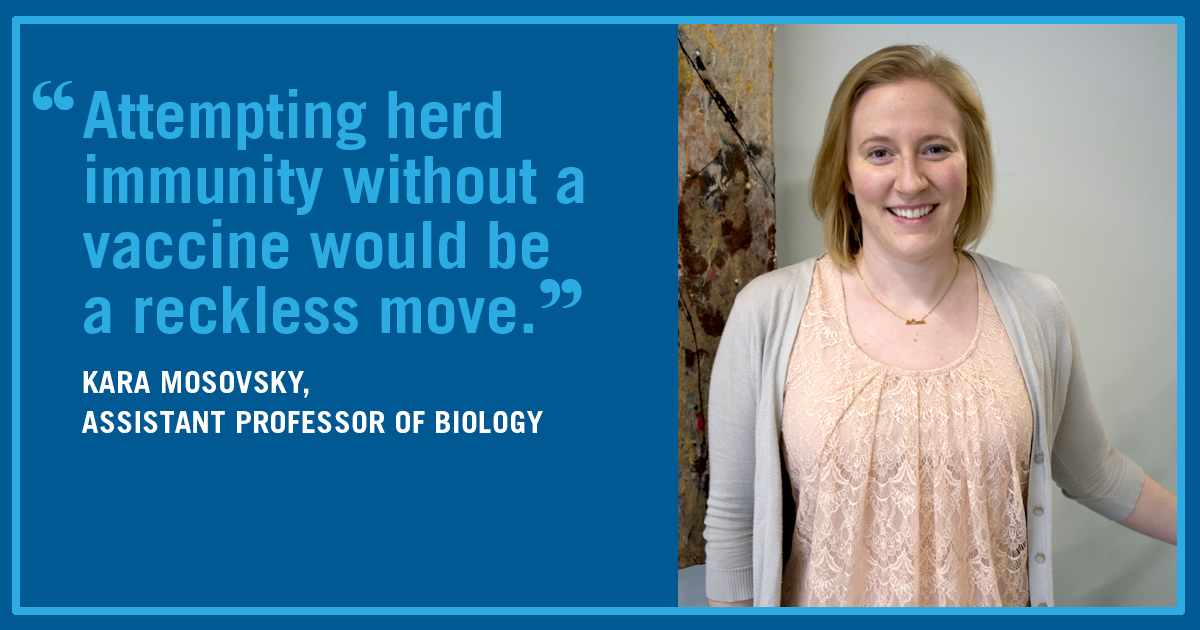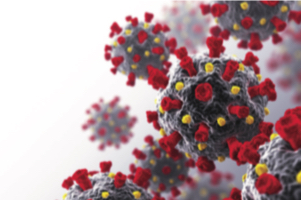

Guest Lecture
Kara Mosovsky
Assistant Professor of Biology
Understanding COVID-19
The emergence of SARS-CoV-2 (the virus) and the disease it causes (COVID-19) has had devastating effects at all levels of society and throughout the world. From an academic perspective, though, it has been fascinating to study, bringing renewed relevance and urgency to my disciplines of microbiology and immunology as well as those of nursing, public health, and epidemiology. I have chatted more about microbiology outside the classroom in the past six months than over the past six years, and I’ve answered several questions from friends and family and cleared up some misunderstandings.
How are viruses different from bacteria?
To begin, viruses aren’t alive. They aren’t even cells like bacterial, fungal, or protozoan groups of pathogens. At a simplistic level, viruses are composed of proteins and some hereditary information contained in DNA or RNA, and some (like SARS-CoV-2) have a thin lipid or fatty coating. Remember learning about the cell membrane, nucleus, mitochondria, and cytoplasm of cells? Viruses don’t have any of that. They are obligate intracellular parasites, which means that they can’t do a darn thing outside of a living host cell—they can’t replicate, they can’t make more proteins, they can’t turn your cells into a virus-factory, and they can’t cause damage.
How are viruses transmitted?
Viruses are all around us, on every surface that we touch, in the air we breathe, and on the food we eat, but most viruses—as is also true of bacteria—aren’t “bad” for us, because most viruses can’t infect us. The only way they can move in the environment is if they attach to some surface (your hand or clothing) or if air currents from a cough, sneeze, or a quick movement pick them up and carry them away.
How do viruses infect us?
Every virus requires a specific cell receptor in order to gain access to the inside of our cells, sort of the way a key matches a lock. Once inside, they can replicate, make more proteins, and turn a human cell into a virus-making factory, which can eventually damage or even kill the host cell. A virus like polio can attach only to specific receptors present in the gut and in the nervous system, which explains why a person with polio can present with neurological symptoms. The “flu,” short for influenza virus, attaches to a specific receptor found mainly in our respiratory tract. You cannot give the flu to your dog or cat, because their respiratory tracts do not have the same specific receptor that can bind the virus, so snuggle away!
What receptor does the coronavirus require, and why are COVID patients affected so severely?
Scientists have discovered that SARS-CoV-2 attaches to the ACE-2 receptor, which is found on cells in the respiratory tract but also many other tissues around the body. This helps to explain why other parts of the body are affected and damaged by the virus, too, although much more research is being conducted to understand more. In some cases, the body’s own immune system might also contribute to some of the damage from the virus; think of it as a war zone in which innocent bystanders are affected by the immune system’s attack on the virus.
Where are we with the vaccine trials?
As I’m writing this, there are roughly 45 vaccines in human clinical trials and many more than that in preclinical testing stages. Although six vaccines have limited approval or emergency use authorization in other parts of the world, no vaccine has received approval by the Food and Drug Administration (FDA) in the United States. For updates on vaccine development, visit The New York Times vaccine tracker at mrvn.co/vaccinetracker.
“I don’t want to be among the first people to receive the COVID vaccine when it is approved.”
You won’t be. By the time the vaccine is approved by the FDA, it will have been given to thousands of people (generally people most at risk of contracting the disease). Here’s how the clinical trials work: Vaccines are tested for safety and efficacy in animals before entering initial safety trials as phase 1 clinical trials in humans with a small number of people. In phase 2, the vaccine is given to hundreds of people with the point of characterizing the immune responses to the vaccine (do people make antibodies, generate memory responses, etc.). Continued monitoring of safety is part of phase 2 trials as well. During phase 3 (typically the longest phase), the vaccine is given to thousands of people. Safety is monitored closely, once again, as are any side effects that may be either so rare that they are only noticed when the vaccine is given to so many people, or don’t manifest until weeks or months down the road. Phase 3 is where scientists and medical experts can really determine if the vaccine works the way we hope—does it confer protection against reinfection and disease in those that receive the vaccine compared with those that receive a placebo shot of saline? This phase can take a while, though— from six months to a year—because we have to wait for people to be exposed to the coronavirus on their own in order to see whether the vaccine is protective.
What is herd immunity, why have some people argued for it during the pandemic, and should we be trying that approach to controlling COVID?
Herd immunity occurs when the built-up immunity of a population effectively protects the nonimmune individuals within that same population. Herd immunity does exist for certain infectious diseases (only because of vaccines!) and is effective, but here’s the catch—a large proportion of the population must be immune to the disease for herd immunity to work. In the case of measles, for example, herd immunity kicks in when about 95 percent of the population is immune through vaccination. When immune individuals are exposed to the measles virus, they clear it quickly without becoming spreaders themselves. In effect, they become a dead end for the virus. In the case of measles, herd immunity is possible only because we have an effective vaccine against it and the vaccine is widely used. The same cannot be said of COVID yet.
Building herd immunity against COVID, without a vaccine, would require a significant portion of the population to be exposed to the virus, survive the infection, and develop immunity (which seems to vary by individual). Attempting herd immunity without a vaccine would be a reckless move. Besides, there are still too many unknowns about this new virus: What kind of exposure stimulates immunity? How long will that immunity last? How does the virus cause lasting damage to the body? With time, science can answer these questions.
